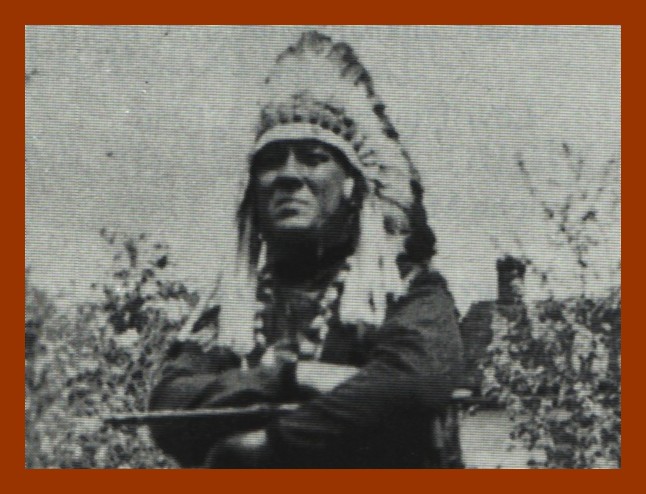An undated photograph of Chief Joseph Strongwolf, an Ojibiway Indian who gave a featured address at the 15 May 1926 Fort Halifax Marker dedication and unveiling.
In the same year the monument was dedicated, Chief Strongwolf spoke in many of the Lykens Valley area churches.
On 23 October 1923, the Altoona Tribune published the following background story on Chief Strongwolf:
OJIBWAY CHIEF STUDIES AT PENN
Strongwolf, Student and War Veteran Delves Into Ethnology
PHILADELPHIA, October 22 [1923] – Chief Joseph Strongwolf, of the tribe of Ojibways, is the lone representative of the original America races, among the 16,000 students registered at the University of Pennsylvania. He is studying ethnology and anthropology with the intention of educating his people of Wisconsin in the traditions of their race.
“There is a great wealth of material about the American Indians of invaluable historical importance which has not been brought to light,” he said. “I believe that if my people try to be good Indians rather than good white people, they will reassert their ancient position and become an asset rather than a financial drain to the great American government.”
Chief Strongwolf studied for three years at Leland Stanford University, California, and then came to the university to finish his courses.
He was the first Indian to enlist in the World War and the first one to enter active service. He enlisted in the English Second Battalion, Oxford and Bucks Light Infantry, and was one of the “Contemptible Army” of 100,000 which helped to stop the Teuton’s onrush to Paris through Belgium. He was wounded twice, and served in the engagements at Ypres and Paschendale.
Looks for Many Discoveries
“I am interested in persuading our people to form their own societies and to retain their old traditions. I believe that the Indian has left a far greater impress upon the culture and civilization of the present than ever our modern historians and sociologists realize. The whole trouble is that our histories have given the youth of the United States the wrong impression as to the civilization of the American Indian. People speak tritely of the ‘noble Red Man.” and then laugh when one speaks of the contributions which he has made to present-day culture.”
It is the belief of the chief that many remarkable things will be discovered if the records of the Indians are searched with as scrupulous care as that given to remnants of Egyptian civilization.
“The ancient tribes had a form of representative government, free speech, freedom in religion, belief in a Divine Creator, and a respect for woman long before the white man was received by Chief Massasoit and his friendly warriors in New England. The Indian is reputed to be a savage and a tyrant to his women folk, yet it is a fact that the Indian always fought on the maternal side of his family, and invariably traced his ancestry through the maternal line.”
Chief Strongwolf expressed the belief that Carlisle and other Indian schools were run upon the wrong assumptions by the government.
“To put stress on athletics is well, for the Indian begins to wither when he is penned up in steam-heated rooms, but it is wrong to attempt to make a white man out of an Indian. When the Indian becomes a white man, in outward respects at least, he loses that all-important background of his traditions, and he becomes a mongrel, and something of an outcast. It the government had only attempted to make good Indians out of those placed in the schools, they would have now a group of men who would be accomplishing something for the country.
________________________________________
Photo from the 200th Anniversary Book of Halifax and Surrounding Area, published in 1994.
Corrections and additional information should be added as comments to this post.
[Indians]
